Uranus and Neptune are the farthest planets in the solar system, about 2 billion to 3 billion miles away from the sun. They are sentinels outside the solar system. Most people pay little attention to these two ice giants and even think they have nothing to do with us. They are even less famous than their little brother, the dwarf planet Pluto with its own "love".
However, for planetary astronomers, their size and location have always been a mystery. Because to some extent, they should not exist, or at least they should not exist where they are.
What scientists cannot understand is how these giant planets became so large and so far away from the sun.
Why do scientists have such questions? Let's go back to 4.5 billion years ago... When the solar system was born.
At first, the sun was ignited by a disk of gas and dust. At the same time, the rocky cores of the first planets began to grow, and they collided with debris on the disk as they revolved around the sun.
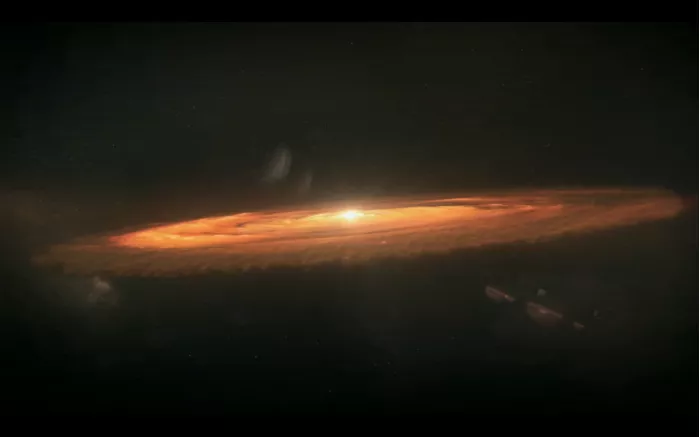
An imaginary picture of the solar system when it first formed
But inner planets are limited in size. To grow into a giant planet, gas is needed. The heat from the newborn sun will erupt these lighter gas molecules beyond what astronomers call the snow line.
The temperature here is enough to stabilize gas molecules such as hydrogen and helium. Jupiter and Saturn were the first to take shape, swallowing up rich gas and quickly becoming gaseous giant planets.
But Neptune is different from Uranus. Jupiter and Saturn have about 90% hydrogen and helium, while Neptune and Uranus have closer to 20% hydrogen and helium
So what does this difference in gas tell us?
Scientists suspect that Uranus and Neptune appeared later because there is not so much gas to collect.
Uranus and Neptune do not have much time to absorb hydrogen and helium before hydrogen and helium disappear. But because they are farther away, where it is cold enough and other heavier gases freeze there, these gases are swept away by the growing outer planets.
Where Uranus and Neptune are located, there are tons of ice. Of course, these tons of ice refer to the frozen gas composed of methane, ammonia, water, etc.
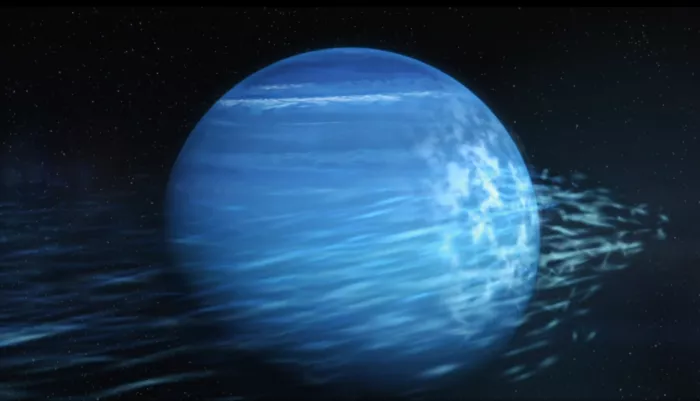
Imagination of Uranus formation process
They may be smaller than Jupiter and Saturn, but these heavy ice means that their density will increase. As the ice giant planets of the solar system, Uranus and Neptune seem too big.
Know that the disk of gas and ice around newborn stars will not exist forever. And the material in the depths of the solar system is very thin. When they travel deep in the solar system, the time for the two celestial bodies to collide and accrete with each other becomes slower.
Because the revolution cycle around the sun is much longer, it takes a very, very long time. Neptune and Uranus orbit the sun so slowly that they cannot collide with enough ice to form the giant planets we see today
So when scientists observe Neptune in this very distant orbit, the orbit of the solar system should not have enough time to build a planet like Neptune.
For a long time, scientists have been puzzled by this puzzle. With the development of science and technology, this mystery can be solved only when mankind can finally explore exoplanets.
[Uranus and Neptune swapped positions]
When scientists explore exoplanets, they find that planets with mass like Neptune are very common around other stars, but they are not where we found Neptune.
In fact, what is found around other stars is that Neptune mass planets are very common, but they are very close to stars, and many are very close to the orbit of mercury in our solar system.
In our solar system, Neptune and Uranus are incredibly far from the sun. In other star systems, however, ice giants are incredibly close to their stars.
So what happened?
If readers read the author's previous popular science articles, they will know that the planets in the solar system seem to be very stable in their orbits, but in fact, things are in a delicate balance, and the orbits of planets often change in the life cycle of the solar system. They don't form in one place and stay there forever.
In other words, the place where we see planets now is probably not where they first formed.
So what has enough power to move a giant planet like Neptune?
A bigger planet... Jupiter.
It can be said that when it comes to the solar system, Jupiter, a "bully", can't get around. It is the largest of the planets, and its every move affects other things in the solar system.
Planets have a way of moving through interacting gravity. So they can feel each other's gravity, which can drag or pull. This effect will lead to the slow migration of planets in their planetary system
At the beginning of the formation of the solar system, the distance between giant planets was much closer. The closer the two planets were, the greater the influence between them.
Most importantly, their orbital order may not be the same as what we see today
The order at that time was Jupiter, Saturn, Neptune and Uranus
So what caused Neptune and Uranus to exchange positions?
The answer lies in Jupiter and Saturn. The two largest giant planets staged a gravitational dance. There is always this interaction between them.
Over millions of years, a rhythm slowly formed, and these giant planets pushed and pulled each other into more elliptical orbits.
When the dance of gravity reached its climax, the stretched orbit became unstable and the giants deviated from their course.
When Saturn and Jupiter move away from the sun, they throw Neptune out of Uranus. When Neptune crosses the solar system, it pushes debris in front of it.
These are ice fragments left over from the formation of planets, and Neptune will push these bodies out. This is the origin of the Kuiper belt
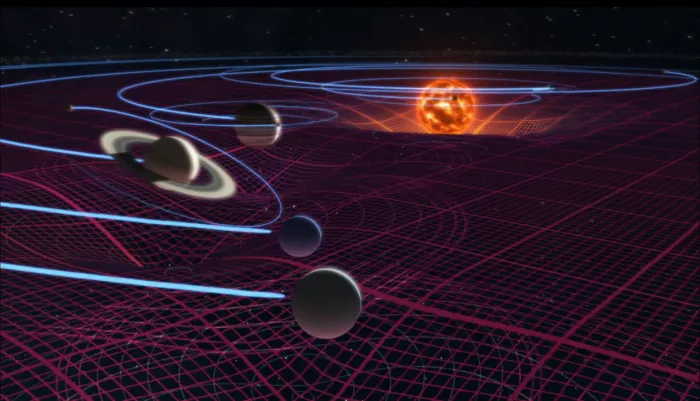
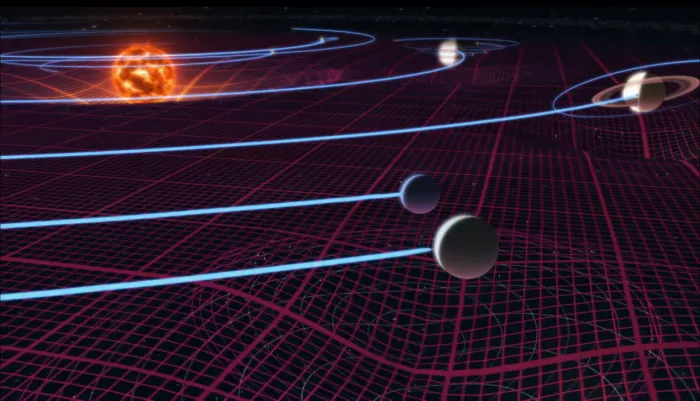
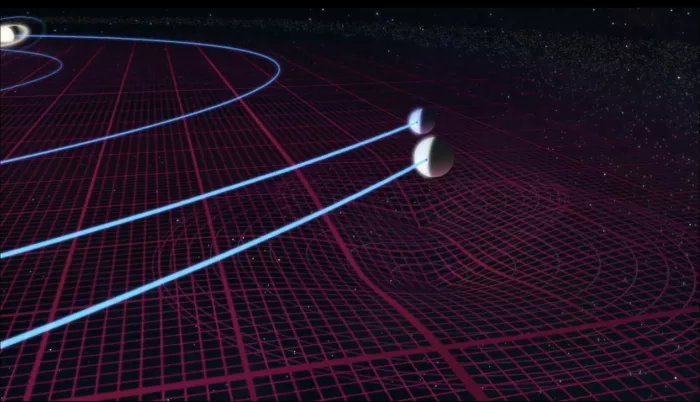
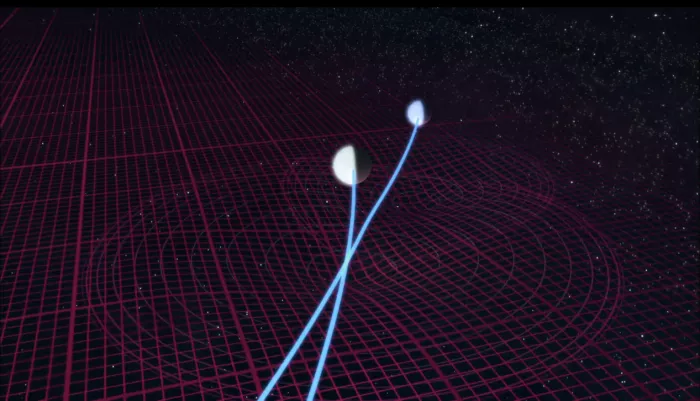
Neptune is thrown out of Uranus by the gravitational dance of Jupiter and Saturn
This small belt of thousands of ice and rocks is just outside Neptune's orbit. You can think of the structure of the Kuiper belt as "blood on the wall at the murder scene".
This is the record of Neptune crossing the solar system when it moves violently outward.
But Neptune's motion not only threw these small ice bodies into the Kuiper belt, but also caused some of them to hit the interior of the solar system, and some bombed the early Earth.
This is the most violent period on earth since the birth of the solar system, which is 500 million years after the formation of solar combustion. This is known as the late heavy bombing period.
In the late heavy bombing, if you are lucky to live on earth, you will continue to see stones falling from the sky.
This will be the worst moment of life. However, this series of ice bodies also bring what is necessary for life.
One of the characteristics of celestial bodies in the periphery of the solar system is that we can often find organic matter. Organic matter is the basis of all organisms we find today. They are carbon based molecules formed on the surface of dust particles in the early solar system.
Although rocky inner planets also carry these organics away as they grow, the scorched surfaces of these young planets are too unsuitable for these fragile molecules to survive.
However, the organic matter remains intact on these small ice bodies that Neptune threw into the outer solar system of the early Earth.
In a way, Neptune is the cosmic messenger of the solar system. Therefore, the existence of ice giants outside the solar system may be crucial to the existence of today's earth. These ice giants may not only provide power for life on earth, they may also prevent our planet from being completely destroyed.
[the ice giant protected us]
About 4 billion years ago, the young earth was threatened by the solar system "bully" Jupiter, which is located between the rocky inner planet and the giant outer planet. Jupiter rules the entire solar system.
As Jupiter and Saturn lock in their gravitational dance, they move outward and begin to move away from the sun. Jupiter's great gravity will pull the earth and Venus together. The orbits of earth and Venus should stretch and overlap each other. This will be an impending collision
Fortunately... It didn't happen. So we can talk about this fact on earth.
So what protects us? Scientists believe that something pulled Jupiter into different orbits before Jupiter had the opportunity to pull earth and Venus into collision orbits.
But what led to such a big leap in Jupiter's migration? At this time, in this story, the ice giant appears. It's not easy for Jupiter to make a big jump in the process of migration.
The scientists reproduced the jump through a computational simulation program. Let Jupiter eject Neptune sized objects completely from the solar system.
Jupiter has great gravity. If you are too close to it, you will be accelerated in the process of falling to Jupiter, which may throw a planet completely out of the solar system.
But even for Jupiter, a planet the size of Neptune is still very heavy. Ejecting it out of the solar system will give Jupiter a reaction. Jupiter will be placed in a new orbit and the earth will be saved.
But we know that Neptune and Uranus are still moving in the solar system, and they have not been thrown out of the solar system. So which ice giant sacrificed himself for us?
If we use computer simulators to predict the behavior of planets, we will find that if only Jupiter, Saturn, Uranus and Neptune, it is impossible to save the earth without ejecting Uranus or Neptune.
But they're all there, so scientists know it's wrong. However, if you add a third ice giant, everything will go smoothly. Our earth is really saved.
Therefore, in the solar system, there are likely to be three ice giants at the beginning, one of which is too close to Jupiter. Our solar system bully threw the victim out of the solar system. Jupiter is also pushed into a new orbit by the gravity of the ice giant planet. Finally, the earth got rid of Jupiter's deadly gravity, and the solar system became the safe and orderly place we see today
Therefore, as human beings on earth, we should thank this unknown ice giant, although it no longer exists.
[ missing ice giant ]
So where is the missing ice giant now?
The answer is amazing. It may be on the other side of the galaxy.
The sun orbits the Milky way at a speed of 500000 miles per hour. In the history of the earth, we have circled about 20 times.
We may lose that planet anywhere in the galaxy, but is the third ice giant really lost or just hiding?
In January 2016, astronomers at the California Institute of technology announced a surprising news: they claimed to have found evidence of a mysterious ninth planet outside the Kuiper belt.
The simulation shows that if the so-called ninth planet exists, it is similar in size to Neptune and Uranus.
Will it be the Savior of the earth? Is it possible that the self sacrifice ice giant, which was originally missing in the solar system, is the ninth planet?
Yes, it can be!
Perhaps the third ice giant did not eject from the solar system, but revolved around the young solar system in a very, very long cycle.
The ninth planet is considered to be a very distant planet. It takes 20000 years to go around the sun.
Because this planet, which is thought to be the ninth planet in the solar system, is too far away, no telescope has found it yet.
If it is proved to exist, our textbook may have to be rewritten again. The solar system once again has nine planets.
Whether the ninth planet is a long lost brother planet or not, ice giants have played a huge role in taming Jupiter. They make our solar system a refuge today.
Neptune has the fastest wind in the solar system
Uranus and Neptune are located on the edge of our solar system, which makes them difficult to study. So for scientists, they are very mysterious.
These planets have long been neglected because they are difficult to observe with earth's telescopes.
The only time we saw these distant giants at close range was when Voyager 2 flew over them in the 1980s.
Scientists were shocked when they first saw a close-up picture of Neptune. They found that Neptune has the fastest wind in the solar system.
On earth, our wind is actually driven by different temperatures and sunlight.
Neptune is 3 billion miles from the sun, so far away that it receives almost no energy from our parent star.
It's really cold there. Why is there such a fast wind?
Scientists have long believed that the less energy a planet receives from the sun, the quieter its weather will be
But Neptune is not calm at all. It is covered by violent storms, some of which are the size of inner planets.
It was a fairly large storm, and one of the biggest storms on Neptune on record was the big black spot in 1989.
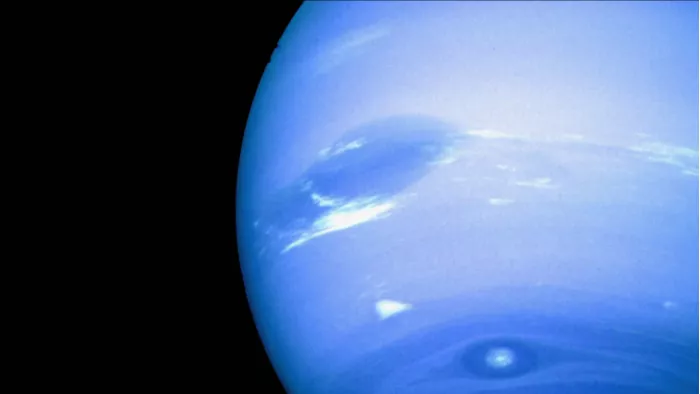
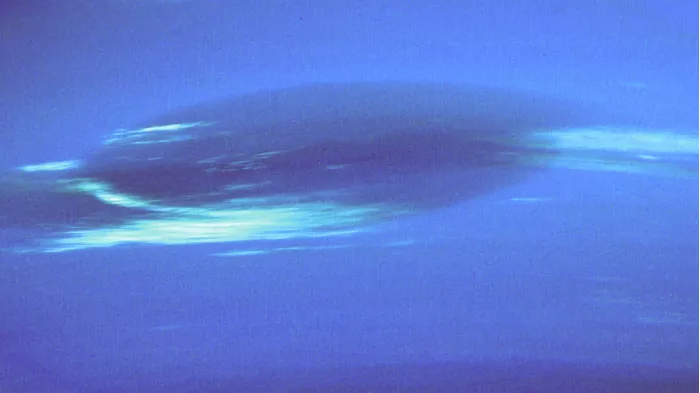
The big black spot on Neptune
It was a huge storm, big enough to engulf the whole earth. At an amazing speed of 1500 miles an hour.
The fastest tornado on earth has a wind speed of only a few hundred miles per hour, but it has caused devastating damage.
So it's hard to imagine the impact of the wind on Neptune. The detector entering Neptune's upper atmosphere recorded a freezing temperature of minus 224 degrees Celsius.
It's so cold that it shouldn't blow. However, at 600 miles, the probe was shattered by Neptune's relentless jet.
The deeper you dive, the higher the temperature. The heat generated inside Neptune is almost three times that generated by the gas ball on Neptune's surface.
Strangely, these high-speed Neptune winds are not driven by the heat of the sun. In fact, they are powered by the heat inside Neptune.
So where does this internal heat come from?
When planets formed, it was a very violent and energetic event. At this time, the planet is very hot, and it will take billions of years to release the heat.
So Neptune may still have a lot of heat trapped inside. When the heat comes out like a foam, it will heat the atmosphere and eventually lead to this kind of bad weather.
So how does Neptune retain so much heat?
The secret lies deep in the atmosphere. When you keep going down, you will find that the pressure is increasing. Until you're finally crushed. The atmosphere will get thicker and thicker, like fog, and finally you will suddenly realize that you are already in the ocean.
Neptune has a high-density fluid mantle composed of methane, ammonia and water. Therefore, ice giant planets are not solid ice hockey, but a moving ocean composed of rotating liquid matter.
This rotating liquid will retain heat and isolate the core like a blanket. This is the secret of Neptune's bad weather.
In Neptune's methane rich mantle, strong internal heat and pressure may have another unusual effect.
Under very strong pressure, methane decomposes. Methane is made up of carbon and hydrogen, so if you compress carbon to the extreme, you can get diamonds.
So it is entirely possible that there is a torrential rain of diamonds in the ocean of Neptune's liquid mantle
[Uranus is the real mystery]
Uranus is arguably the strangest planet in the solar system.
In January 1986, Voyager 2 approached Uranus at a speed of more than 40000 miles per hour. Astronomers have been waiting for this moment for eight years.
Before Voyager arrived, what scientists knew as Uranus was just a dull, pale blue sphere.
Now we can finally see the mysterious giant planet.
The most striking feature of Uranus is its tilt angle. Although all planets are tilted relative to the solar system, the earth is 23 degrees and Jupiter is only a few degrees. But Uranus is actually lying on its side. It tilts 98 degrees.
Uranus tilts almost four times as much as other planets in the solar system. It lies flat, so its poles are horizontal, and its rings and satellites are perpendicular to the plane of the solar system.
The tilt of the earth makes the four seasons distinct, while the extreme tilt of Uranus gives it extreme seasons.
Its poles point directly to or away from the sun twice a year. So every polar region has a very strong noon sun and a dark, cold polar night.
Uranus takes 84 years to orbit the sun, so these seasons will last a long time. When the northern hemisphere has 20 years of sunshine, the southern hemisphere has 20 years of darkness.
Uranus is a bit like a "game of power", waiting for a long winter, and then the winter lasted 20 years.
When the sun shines on the equator, the whole planet is illuminated. Sunlight hits the equator of the rotating planet, pumping energy into the surface, warming the atmosphere and driving the airflow around the planet.
As a result, in the spring and autumn of Uranus, huge storms wreak havoc on the planet.
So, unlike its ice giant brother Neptune, Uranus's storms are seasonal rather than constant.
So why does Uranus revolve around the sun like this, while other planets rotate like a top?
This runs counter to what we know as the process of planetary formation.
The process of forming new planets in the solar system is much like making marshmallows. Everything is rotating in one direction. If you put a stick in it, matter will gather around it in a certain direction.
This is why all planets have roughly the same orbital axis.
Therefore, Uranus should initially have a vertical orbital axis. How did it turn over?
We know that in the early solar system, many planets or objects the size of planets collided with each other.
It is natural to think that Uranus may have been slightly hit by another huge object, causing it to tilt to one side.
But there is a problem with this assumption. If you make a simple impact on Uranus, knock it down to 98 degrees. So what you actually expect is that the rest of the rings will rotate in the wrong direction relative to the planet.
What events can be powerful enough to flip a planet, but gentle enough to bring everything around it into orbit?
A single big collision cannot happen on Uranus. Because it would cause too much damage.
It's a bit like boxing. It's not a fatal blow, but a relatively weak one punch, two punches and multiple hits.
Therefore, one theory holds that the newly formed Uranus was hit by a protoplanet the size of the earth. The blow was just a skim, and Uranus was hit in its current tilt direction. Its ring system withstood the impact and stayed in orbit near the equator**
When the second celestial body collides with Uranus, Uranus tilts all the way, and the aura changes accordingly. Finally, Uranus orbits the sun in the form of lying on its side
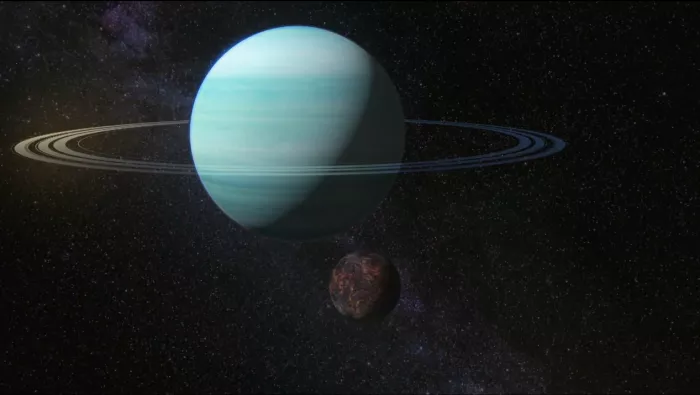
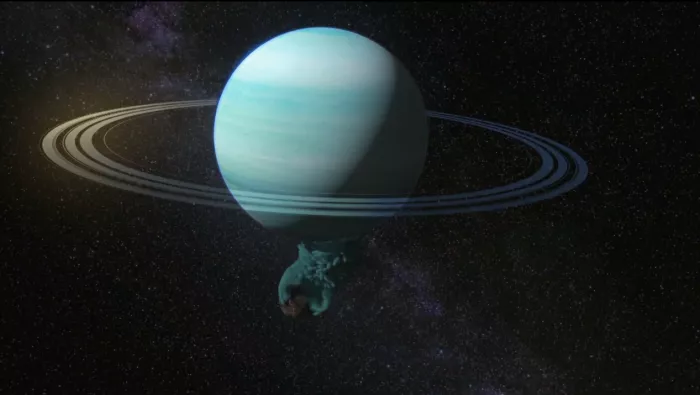
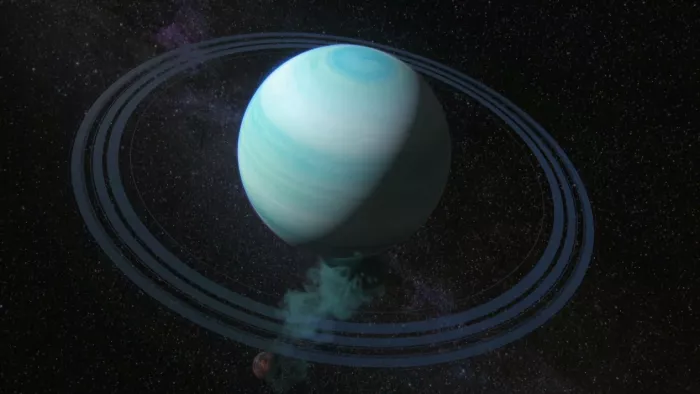
Image of Uranus's first collision
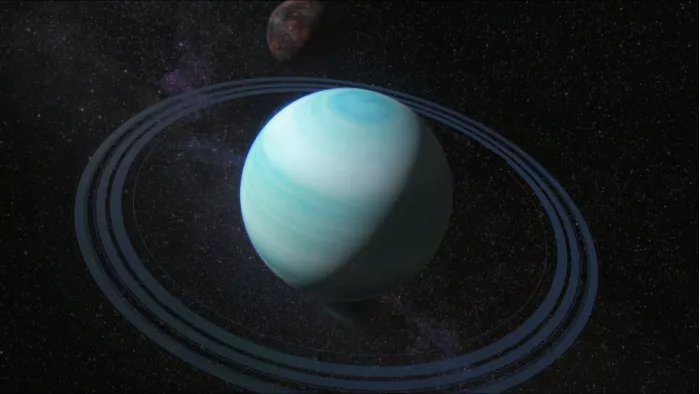
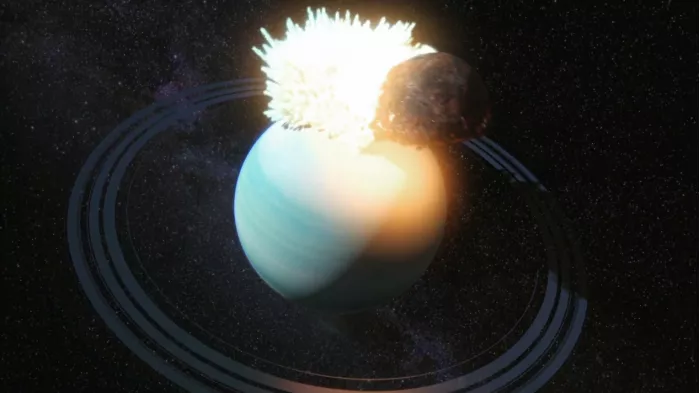
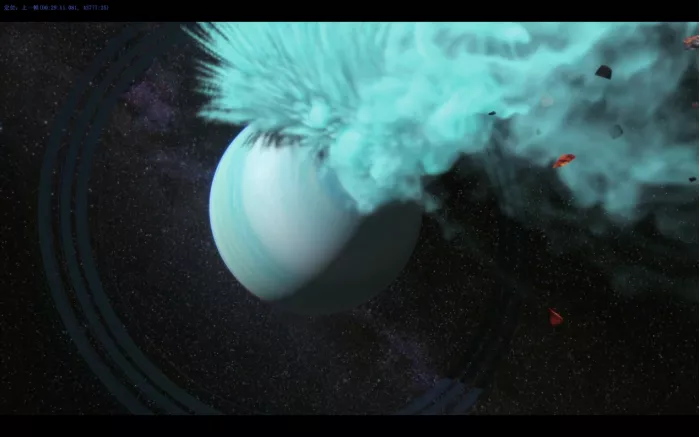
Image of Uranus's second collision
Neptune has a strange moon
Uranus and Neptune have many moons. So far, astronomers have found 27 satellites around Uranus and 13 around Neptune. But among the 13 satellites, one is very strange, which makes it "stand out among the many satellites".
It's Triton, which has a more strange orbit than Uranus lying on its side. It actually orbits Neptune in the opposite direction. We call it retrograde orbit.
A giant planet and its moon are formed by a spiral disk of the same gas, dust and rocky material. Lighter gases are more likely to fall into the center and form planets. Some heavier rock material remains on the disk to form satellites.
Usually, the direction of a satellite is the same as that of a planet. But the opposite is true for Triton and Neptune.
So scientists believe that it cannot form in the orbit around Neptune.
It must have come from somewhere else, and a wonderful clue about where it came from is its neighbor, Pluto.
Pluto is a dwarf planet near the Kuiper belt. It is only 200 miles smaller than Triton.
But the similarity between the two celestial bodies lies not only in their size, but in their composition.
Triton is actually the most similar to Pluto, with a similar number of rocks inside. Its surface composition is similar, containing a large amount of nitrogen and methane. It really looks like a Pluto like world. But it only revolves around a planet, not around the sun.
If Triton is like Pluto, maybe it was born in the Kuiper belt. Will it be captured by Neptune's gravity and pulled into the orbit of this gas giant?
It's not easy to capture the satellite in the orbit around the planet. When an object approaches another world and spirals in, you have to stop the car.
So if Neptune wants to capture Triton, it must slow down Triton, but how?
The objects in the Kuiper belt provide clues again. In the Kuiper belt, many of the largest dwarf planets are binary stars, two worlds that surround each other. For example, Pluto and its big moon Pluto.
Maybe Triton is one of them. If Triton and another partner are in orbit, each pair will travel at a different speed. This speed difference is the key.
Triton is a little slower. It's rotating around its companion star. It's slow enough to be captured by Neptune.
The other was accelerated by Neptune and thrown out. In this way, Triton's original partner disappeared because it had a larger new partner, Neptune.
Besides having a strange orbit, Triton has a more strange puzzle.
On satellites like Triton, scientists expect to see a lot of crater terrain. This is the geological symbol of the dead world. On the contrary, however, Voyager 2 reveals an amazing living world.
When Voyager 2 flew over Triton, scientists saw a jet of liquid nitrogen gushing from the surface of Triton.
Unexpectedly, this small and cold world is still "alive". Smooth ice covered the planet's surface, and nitrogen geysers spewed upward through the earth's crust, spewing five miles of black dust into the sky.
Scientists always thought it was too far away from the sun, too cold and too dead. It was just a hockey ball like other satellites, but it wasn't.
Where does the heat that drives these surface features come from?
The answer is that Triton was captured by Neptune. Triton's orbit is now circular, but it used to be oval.
As Triton moves closer and farther away, it will continue to be squeezed and stretched by Neptune's gravity. This will create a lot of friction inside Triton.
Under the influence of these forces, Triton may melt completely. When this happens, it will act as a brake, and all this friction will turn Triton's orbit into a circle and make it run in the orbit we see today.
It is this change in orbit that gives Triton heat. Although the surface of Triton is frozen, the moon still retains some warmth deep in the ice shell.
Astronomers believe there is enough heat to melt the ice into water to form an underground liquid ocean 3 billion miles from the sun.
Since there is liquid water and heat... Then there is an "old-fashioned" question: will there be life?
If Triton has a source of energy, there may be some kind of life that knows how to use it.
So, if Triton has life, this frozen sphere may be the most livable world away from the sun
[Uranus's moons are more strange]
Uranus is an ice giant with a beautiful halo and 27 moons. But the location of its satellite is a mystery. Half of them lie in closely spaced tracks.
So many satellites are so closely arranged that they seem very unstable. Satellites should be colliding.
More surprisingly, in 2003, the Hubble Space Telescope discovered two new rings and two new satellites - "Marber" (Titan 26) and "Cupid" (Titan 27).
The question is, where do these satellites come from?
Scientists believe that when you see a ring system, you actually see part of a process.
For some time in the history of the earth, it may also have a ring. At that time, our moon was forming. That is, the halo of the planet will form new satellites over time.
Therefore, these new moons of Uranus seem to be composed of materials from the previous halo system.
Scientists simulated the moon of Uranus by computer. It was found that Cupid was very close to Belinda, another satellite. For thousands of years, when their trajectories intersect, they are likely to collide.
This collision will produce a domino effect, debris will hit other satellites, and will produce a lot of debris. The last collision will lead to a series of collisions.
Scientists believe that Cupid and Belinda will destroy not only each other, but also all Uranus's internal satellites. A runaway destructive collision will crush Uranus's satellites into pebbles.
The debris will form a ring system around Uranus, and over time, the ring system will begin to hatch new satellites. Then the satellites will collide with each other again and grind each other into dust.
So Uranus's ring system will be smashed into rings in the collision of satellites, and then the rings hatch satellites, so it will go back and forth in a continuous cycle
When scientists looked at the satellite Miranda, they found that the satellite seemed to be reassembled. This may be evidence that debris from previous collisions formed satellites.
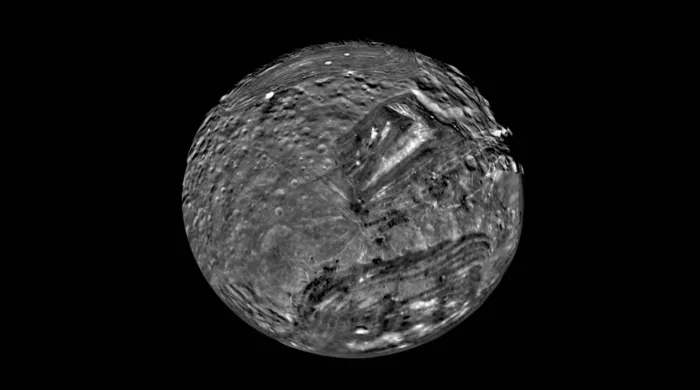
Miranda is like a reassembled satellite
If Uranus's satellites collide and recombine every million years since Uranus first formed, 4000 generations of satellites have been carried out. The system never stabilized, the satellite collided and was destroyed, and the residue was recycled, born, grown, died and reborn.
Ultimately, the eternal cycle of rebirth and death we see on these satellites. This is likely to be a true portrayal of many things in the universe, and may even involve stars, planets, and even the universe itself.
For Uranus and Neptune, scientists only observed them through the moment Voyager 2 flew over them 20 years ago. So this is just a casual observation.
Scientists have learned a lot, but there is still a lot to understand. The only way to know more is to perform a special mission to visit Uranus and Neptune.
But at least scientists already know some stories about ice giant planets. We're talking about them here today because of the existence of ice giant planets. Without them, the earth cannot form and stabilize, and become a paradise for life and living environment.